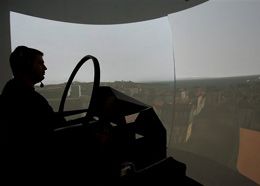Researchers try to improve upon exposed-rotor helicopter design
By AMY TEIBEL
The Associated Press
YAVNE, Israel — Rafi Yoeli has an unconventional solution to saving people from burning high-rises or rescuing soldiers trapped behind enemy lines: a flying car.
Yoeli already has gotten a rudimentary vehicle off the ground — about 3 feet — and hopes to see a marketable version of his X-Hawk flying car by 2010.
Although his dream might seem far-fetched, Textron Inc.'s Bell Helicopters is taking a serious look, teaming with Yoeli’s privately held Urban Aeronautics to explore X-Hawk’s potential.
Think of the people trapped in the World Trade Center. Think of ground patrols in Iraq blown up by roadside bombs. Think of New Orleans residents stranded on rooftops after Hurricane Katrina.
 Watch the related video: Flying Car Seen As Solution For Rescue |
 A worker is seen behind a model of the X-Hawk flying vehicle at the Urban Aeronautics’ headquarters in the central Israeli town of Yavne, Monday. Rafi Yoeli has an unconventional solution to saving people from burning high-rises or rescuing soldiers trapped behind enemy lines: a flying car. He already has gotten a rudimentary vehicle off the ground — about three feet — and hopes to see a marketable version of his X-Hawk flying car by 2010. (AP Photo/Ariel Schalit) Download an animated video from Urban Aeronautics |
X-Hawk and its smaller version, Mule, might one day offer the same capabilities as helicopters, but without the serious operating limitations — like exposed rotors — that helicopters face.
“The reality is that we have not been designing helicopters to operate in urban environments,” said M.E. Rhett Flater, executive director of the American Helicopter Society, a professional group. “What Rafi is doing is addressing that need to design some kind of vehicle that can operate in an urban environment, that can get close to buildings and skyscrapers, and provide some type of relief for people stranded in buildings.”
The concept of a flying utility vehicle dates back 50 years. Other design houses working on vertical lift concepts with enclosed rotors include U.S.-based Trek Aerospace Inc. and Moller International Inc., both of which focus on a different niche, personal-use vehicles.
X-Hawk — for now just a full-size mold in Urban Aeronautics’ headquarters in the central Israeli town of Yavne — looks like a futuristic space car, with its streamlined design, two fans rising from the rear and cockpit-style driver’s seat.
But Yoeli envisions X-Hawk and Mule as more of a truck, pulling up to dangerous combat or terror arenas to ferry in personnel and supplies, and ferry out people at risk.
The X-Hawk will be able to take off vertically, fly up to 155 mph and as high as 12,000 feet, and remain aloft about two hours, Urban Aeronautics says.
But encased fans will replace the exposed rotors that keep helicopters from maneuvering effectively in urban areas or dense natural terrain. A patented system of vanes is designed to afford the vehicle greater stability. Urban Aeronautics says vehicles will be able to sidle right up to a building.
The X-Hawk also will be quieter, offering a stealth advantage over helicopters, said Janina Frankel-Yoeli, the com- pany’s vice president for marketing.
But because the rotor diameter is smaller, the new vehicle will use about 50 percent more fuel.
Yoeli started working on the precursor to X-Hawk and Mule in 2000, but Flater said the 9/11, attacks have “given vertical takeoff and landing vehicles a new priority.”











